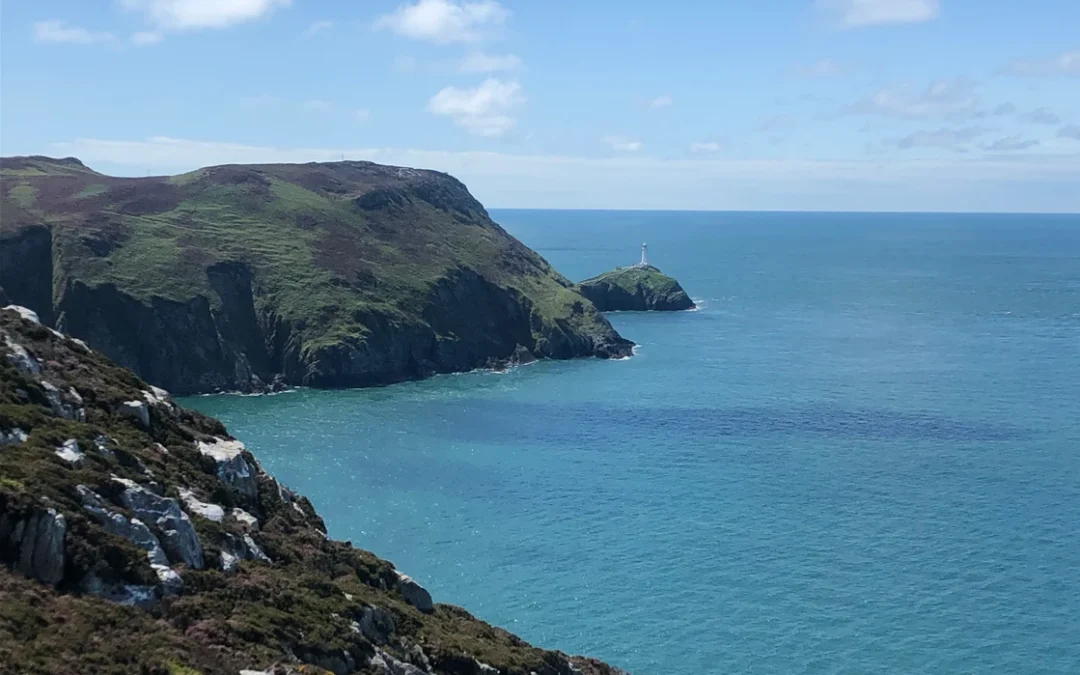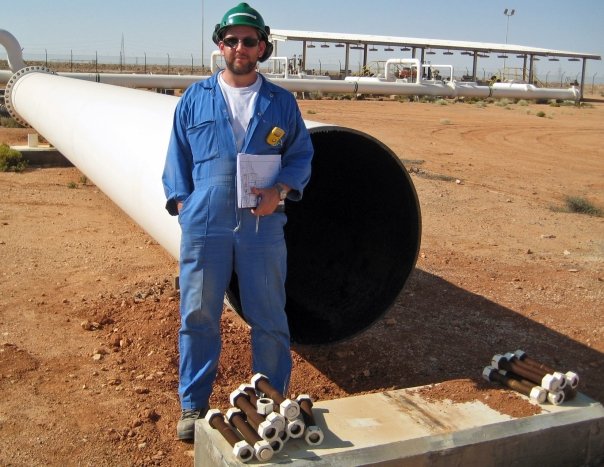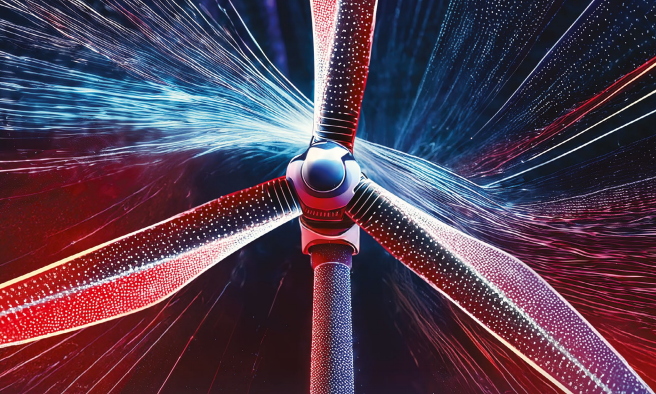Some of us read with excitement yesterday the news that – after almost 10 years of patient pre-development buildup – Menter Môn received government consent to develop the Morlais tidal energy project. Over time this has the potential to generate up to 240MW of low-carbon electricity. Harnessing marine tidal power can be one of the cleanest ways to generate our electricity, and in my view will be brilliant for the future of Holyhead.
So I’ve distilled some of my thoughts below around what this means, why it is important, and where to find out more information.
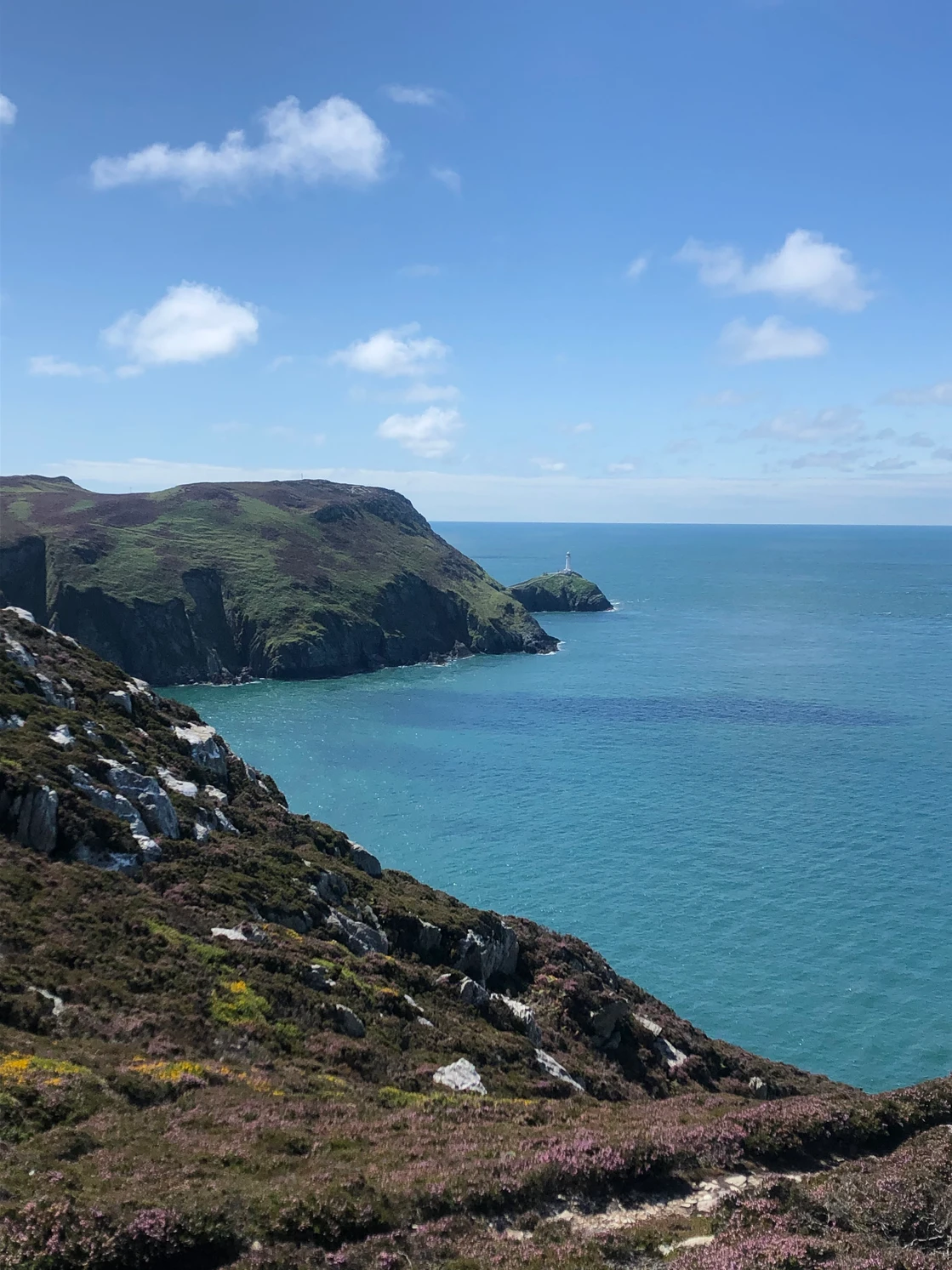
The sun shining on the tidal waters west of Holyhead
World-Class Innovation
The Morlais project is set in the West Anglesey Demonstration Zone licence, just to the west of Holyhead. The exact location can be seen in the interactive Crown Estate map service and other open access mapping portals (for example the Mapstand platform). The setting is shown in the map extract below (taken from the Mapstand app), along with neighbouring existing infrastructure & planned energy developments:
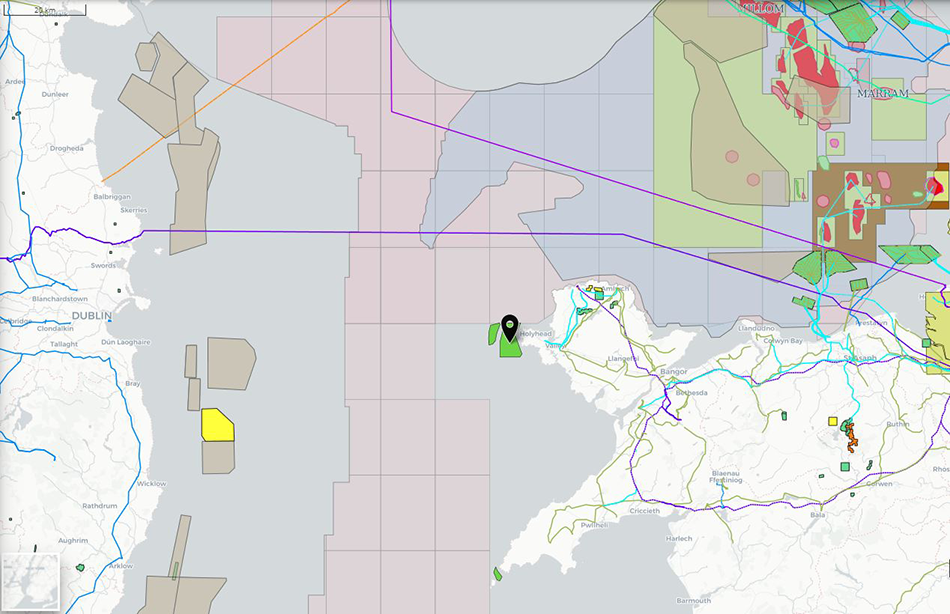
Morlais licence area location (credit: Mapstand platform)
As the licence name suggests, this is a demonstration project. Not a technical demonstration (because the technologies have already been demonstrated in the sea over extended periods at test locations like EMEC in Orkney), but a commercial demonstration. This means that the full power system and it’s connection to the mainland power grid will be tested in a commercial operational environment, at a time when clean energy policies and the associated commercial landscape continue to evolve.
I find it particularly interesting that the Morlais development – in contrast to a developer deploying a single (sometime their own) proprietary technology – the development will allow a range of diverse (and globally-distributed) developers and turbine types to deploy their technologies. Some of these will be fixed to the seabed, some will float, and some will be deployed midwater.
The innovation therefore is in large-scale commercialisation of multiple technologies that have already been proven to work in a similar environment. This is important because climate change innovation impact relies on timely implementation, and requires accelerated deployment of technologies that are ready now.
A Model for Local Ownership & Sustainability
Those that have experience of working in offshore/ subsea energy developments are used to seeing crews of specialist project managers, engineers and workers fly in to deliver a project, commission it, and fly home again. Hotels, restaurants and bars get busy and profit during the project, and ultimately the workers go home or move to the next project. The Developer will make commitments to local content but the real profits leave the area.
What if the developer and the workers were local to the development area? Morlais is different from many projects in that it is being developed by Anglesey-based social enterprise Menter Môn, whose mission is to generate and execute indigenous meaningful projects for the benefit of sustaining local communities. This means that management, project and operational staff are invested in (or attracted to) the local area – and profits made are reinvested in further sustainable growth projects. The project is locally-owned.
It is also worth mentioning that the licence was granted on a 45-year basis. This is the long game: Not merely delivering a project – but creating a generation or two of meaningful learning and skills creation activity through operation and maintenance of this unique system. So if ‘net zero by 2050’ feels like a long time away, Morlais is planned to continue another decade or so beyond that.
The Power Grid Needs Decarbonising. A Lot
One of the government’s key decarbonisation objectives over the coming years is to clean up the carbon intensity of the electricity we consume. This means that for every unit of power we use (in our homes, for charging future cars, industry etc), the generation sources should be replaced so that they release less CO2 to the atmosphere as time goes on. The UK’s grid intensity has decreased over the last 10-15 years (as coal is gradually phased out) from an intensity of around 500g CO2/kWh, to 200-250g CO2/kWh in the last couple of years.
Looking to the future, further reductions are needed and planned: The 2030 target is to have a grid intensity of less than 100g CO2/kWh, and beyond that to reduce to as close to zero as possible through a blend of renewables, nuclear and carbon capture.
So where does marine tidal fit into this? Ocean power is quoted by IPCC 2014 figures as having a median lifecycle (which includes project construction and operational) carbon intensity of only 17g CO2/kWh, within a range of 5.6g minimum – 28g maximum depending on the project characteristics. For info the median carbon intensity of a range of other power generation sources can be summarised as:
- Coal = 820g CO2/kWh
- Natural Gas = 490g CO2/kWh
- Biomass (dedicated) = 230g CO2/kWh
- Solar PV (utility) = 48g CO2/kWh
- Hydro Power = 24g CO2/kWh
- Ocean Power = 17g CO2/kWh
- Nuclear = 12g CO2/kWh
- Wind (Offshore) = 12g CO2/kWh
It is not simple to find blends that meet future targets – so we created a simple interactive calculator [requires free login] to predict the carbon emission intensity of the UK power grid as the blend of generation sources changes. A screenshot of the calculator is shown below:

Olwg’s interactive grid carbon intensity calculator
Using this tool shows that an almost complete elimination of fossil fuels is required to achieve the targets, and that large-scale adoption of renewables and expansion of nuclear is required. One of the challenges with wind and power is it’s seasonal and somewhat unpredictable. Nuclear and carbon capture (of natural gas or blue hydrogen) are dispatchable – but both have very high investment costs.
Tidal Power – if you can get it – is Regular
Tidal only really works in limited areas around the world where there are particularly high tidal speeds, say greater than 2.5m/s. In Europe these locations tend to be concentrated around some of the islands of North Wales + Scotland, and the seas off Holyhead in certain localised areas are blessed with particularly strong tidal flows. There is a lot of energy in these water flows.
Tidal flows are obviously intermittent, but the big benefit they have (compared to solar & wind) is that the flows are completely regular and predicable in all weather conditions & seasons. It could be conceived that tidal arrays dispersed around different parts of the UK coast could in theory collectively provide a smoothed supply of power to the grid, although this possibility for ’round the clock’ tidal is dependent on local subsea topography.
Tidal is reported to have a ‘low’ capacity factor – although Orbital Marine Power recently published some test data (pic below) that confirmed a capacity factor of over 50% in strong tides over 4-5 days at the test location. What this means is that for say a 10MW installed capacity, around 5MW power could be delivered on average over a longer time period.
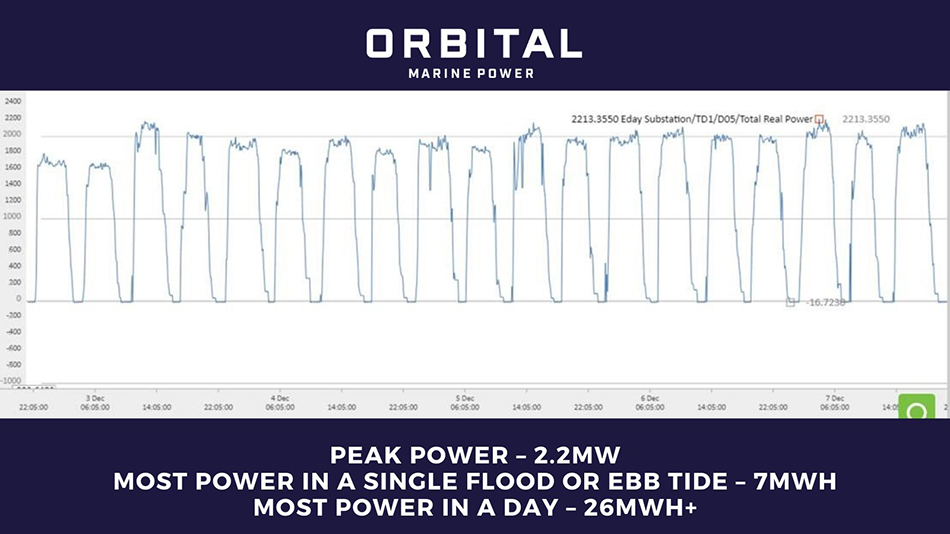
Tidal device capacity factor reported by Orbital Marine
When compared with historical capacity factors for other intermittent renewables, this seems to be considerably higher than for solar – and comparable to offshore wind. The IEA reports average annual capacity factors as the following ranges (which will depend on technology advances and location-specific conditions):
- Solar: 10-21%
- Onshore wind: 23-44%
- Offshore wind: 29-52%
The two key parameters that determine how much power is generated at any location + point in time are i) the tidal velocity and ii) span of the turbine blades. This is the same as wind power. To help understand these relationships, we created a simple interactive calculator [requires free login] to simulate the power output. A screenshot of the calculator is shown below:

Olwg’s interactive tidal turbine power calculator
Given that there are very limited locations in the world where marine tidal can be effective, and that climate goals demand a sharp increase in low-carbon power generation, it makes perfect sense to take advantage of Holyhead’s natural marine resource – and Morlais aims to do just that.
What’s Not to Like?
Renewable energy schemes continue to draw criticism on the basis that opponents consider them to look horrible/ alter existing scenic views and can impact the lives of local wildlife, especially in sensitive environments. These are valid concerns, and in Wales the rigours of the planning process for energy infrastructure projects (and phased ‘learning’ risk-managed approach of many developments) are designed to measure and assess a wide-ranging variety of risks, to ensure that impacts are limited. In the case of tidal, the devices are mostly below the sea – and the turbines only turn quickly when the tides are flowing fast.
When compared with a ‘do nothing’ continuation of using our legacy energy supplies, poor air quality from burning fossil fuels kills an estimated 10 million people a year (plus countless animals, birds and fish) – and the need to clean up our power generation, heating and transports systems is now due.
Unfortunately, as coal / gas / oil has such a high energy intensity (which is what gave us the modern comforts we’ve come to expect in life) it is really difficult to replace with natural renewable means- and not without some impact to the environment. There’s no silver bullet to fixing the environmental damage done in previous decades, and I actually believe that our clean power generation should be fully visible to serve as a reminder and education on where the infrastructure to power our conveniences comes from.
Summary + Further Info
Morlais is a great example of a risk-managed project for climate innovation, low-carbon power generation and local sustainability – and I believe we should get behind these amazing developments!
There’s lots more info on this project development and the technologies involved in the Morlais Energy and Marine Energy Wales websites. There are some great descriptions and animations of the various tidal turbine types on the EMEC website. Selkie Project is a collaborative Wales-Ireland initiative to share marine energy research.
The extensive environmental impact assessments etc and further details of the Morlais project are publicly available for review on Natural Resources Wales portal.
Peer-reviewed technology-specific cost and performance factors (such as carbon emission intensity of power generation and transport options) can be found in the Intergovernmental Panel on Climate Change (IPCC) Working Group 3 Annex iii.
Disclosure of interests:
I grew up in Holyhead (fortunately during a time when the town enjoyed plenty of local industrial employment) – so am naturally biased in wanting to see developments succeed to create high-quality opportunities for future generations of Holyheadians. I have supported Menter Môn’s hydrogen hub development studies through 2021, but have no vested interests in promoting any specific technology or fuel pathway, and my views are based on independent analysis / engineering industry background. As an energy professional I aim to be as objective as possible and continue to learn new things every day – so let me know if something is incorrect.

